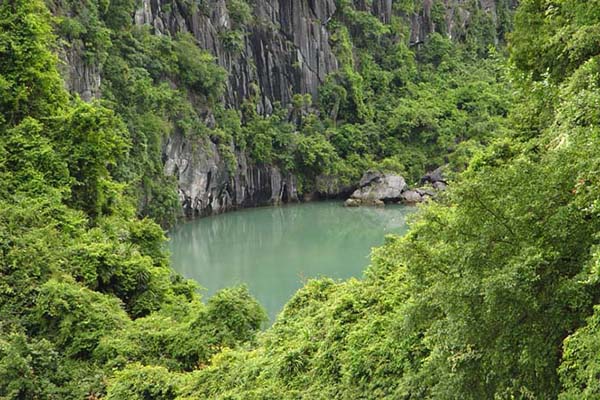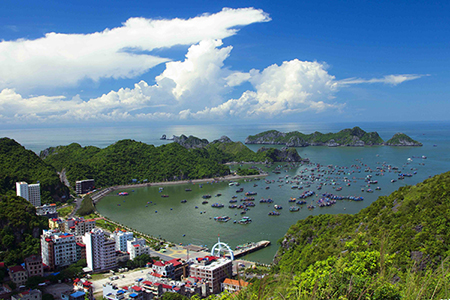The French film Indochine starring Catherine Deneuve, paid renewed tribute in magnificent photography to the "Eighth Marvel of the World", the Bay of Ha Long. But many tourists have not experienced the enchantment of Cat Ba to the southwest of Ha Long, 30 miles from the port city of Haiphong. Only those with lime to spare and who are not reluctant to endure the relative discomfort of the trip can enjoy the many pleasures of this Vietnamese national park.
In the hold of a wheezy boat you can sit among a noisy crowd of vegetable, fruit, shrimp and fish vendors, unless you-prefer to sit on the deck to look at the coast, the immense mouth of the Bach Dang river, and the sea dotted with the sails of fishing boats. After more than two hours you can see in the north the huge mass of the limestone island of Cat Ba, which forms, together with over three hundred islets, the archipelago of the same name.
At that point, you can land on the island of Cat Hai and tour it in a creaky horse carriage, or you may prefer to continue your way with the motorboat, which will go through what is called the Deep Channel to stop at Cat Ba, or more precisely at the administrative seat of Cat Hai district, which comprises the whole archipelago.
To the north, this channel opens onto Ha Long Bay. The National Park of Cat Ba covers 4,200 hectares of sea and 9,800 hectares of forest. Its many-faceted landscape can hold your interest for many reasons: its fjords hemmed in between high cliffs; its yellow-sand beaches washed by limpid Water; Frog Pond in the midst of a virgin forest at high attitude which holds a reserve of water for plants and animals.It has countless rock formations with evocative names: the Pepper, the Mountain Tortoise, and the Lobster are found in the bay of Cat Ba in the south; Boy and Girl, the Bell, the Cock, the Breast of the Elder Sister, and the Breast of the Younger sister are in Lan Ha in the east.

Its caves, which call to mind the robbers of Alibaba, were until 1893 refuges for pirates and rebel patriots who roamed the Red River delta down to the coast. Let us mention the Trung Trang grotto, 400 metres long; and Khe Sau, and the army health service, which sheltered a hospital with operating theatre, cinema, and pharmacy; and the artificial passageway which served as a gun emplacement during the American war and led to the small beach at Cat Co.
The archaeological site of Cai Beo contains vestiges of a 7,000- year-old culture which is related to the Ha Long culture, a link between the Mesolithic and Bronze Age in Vietnam. An old legend explains the topography of the archipelago whose geological formation goes back to the end of the primary era (Uralian).
Long ago, there was a fish monster that used to cause havoc among the coastal population every winter. The Fish-God, Thien Ngu, a handsome young man riding a dragon, engaged the monster in a fierce battle that lasted the whole simmer.
The dragon died of exhaustion, and its body was washed ashore at a place now called Floating Dragon (Phu Long). Its rider landed at a place now dubbed Heel Wharf After killing the monster he threw his sword and club into the sea. They were turned into two rocky islets which received the names of Sword (Hon Got) and Club (Hon Chuy).
He married a fairy coming down from heaven on the back of an elephant. She brought a gourd full of holy water, which restored his strength and fertilized the land. The elephant later turned into a hill which was called by the local people Elephant’s Head.
The couple stayed on earth instead of going to heaven, and hunted and fished for a living.
A foreign visitor once remarked: "I had heard much about the beauty of Cat Ba before my arrival. However, I still had to take a deep breath the first time I saw these grey towers dripping with forests."
On Cat Ba are found several types of tropical monsoon forest: virgin forest, riparian forest (with Salix tetraperina), mangrove, and forest growing on chalky soil alternating with clay.
The flora comprises 620 species, belonging to 123 families, the most valuable of which are: Annamocariya Chinensis, Garcimia fagraoides, Chukraria tabularis, Markhamia sp., Salix tetraperina, Pellophorum lonkinensis, and Caryota bacsonensis.
Let us mention the resurrection of a forest of kim giao (Podocarpus fleuryi) covering 30 hectares. The wood was used to make chopsticks for the emperor's kitchen, for it could show the presence of poisonous substances in the food.
The fauna presents a fairly wide range, with 20 species of mammals, 69 of birds, and 20 of reptiles and amphibians. Found on the cliffs of Cat Bit are some of the world's only surviving enelluses (vooc dau trang, or trapithecucus francoisi poliocephalus).
Other species to be preserved include the goat (capricornis su-matraensis), the macaques (macaca mulatta, macaca nemestrina, macaca arctoidcs), the black squirrel (ratufa bicotor), the porcupine (histrix hogdsoni).
I saw flights of ravens, although these are rather rare on the mainland. Birds include the white-bellied anthraceros mafabirius, the king-fisher (ceryle rudis insignis), the red acthopyga siparaja, and the Garulax blackbird.
In early autumn the tasty-fleshed migrant cun cut come in flocks from the north.
The sea harbours 900 species of fish, 500 mollusks, and 400 crustaceans. Some are highly prized on the market: tobster (palurius sp ), scallop (mytibus sp ), oyster (arcacnarosa), pearl oyster (pinctada margarifera), turtle with scales feretmochely imbricata).
The oyster tu hai (lutrani plilipinarum), grilled over a charcoal fire, is highly appreciated by gourmets.
A British tourist, Tim Scoones, writes: "We marvel at new discoveries every day. In our short stay at Cat Ba we saw the enormous potential of the island as a shrine to the beauty of the natural world."



